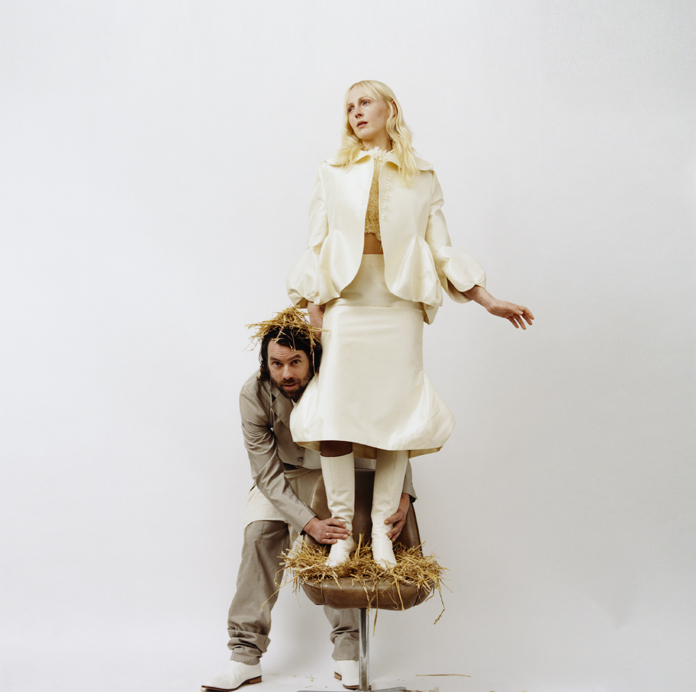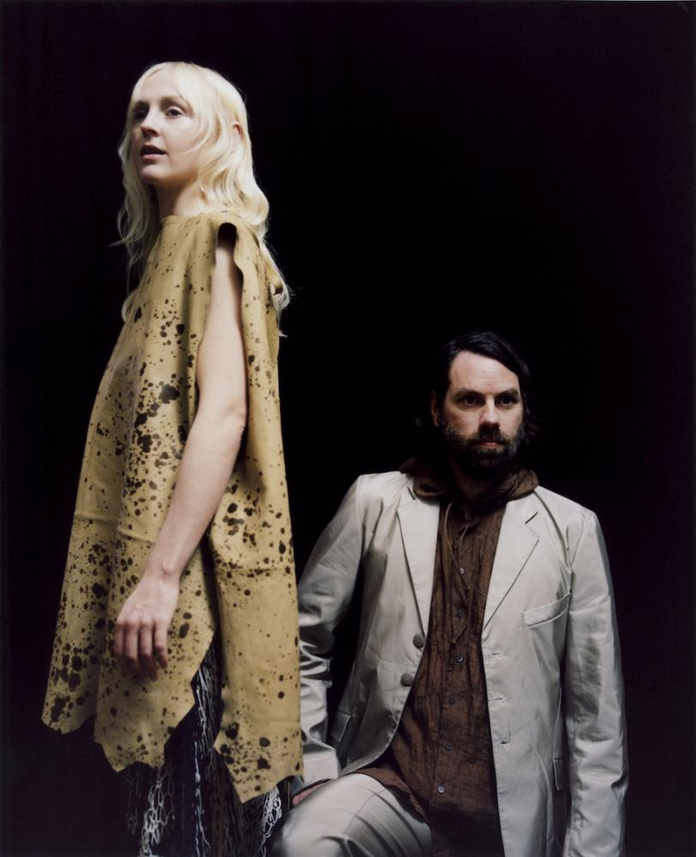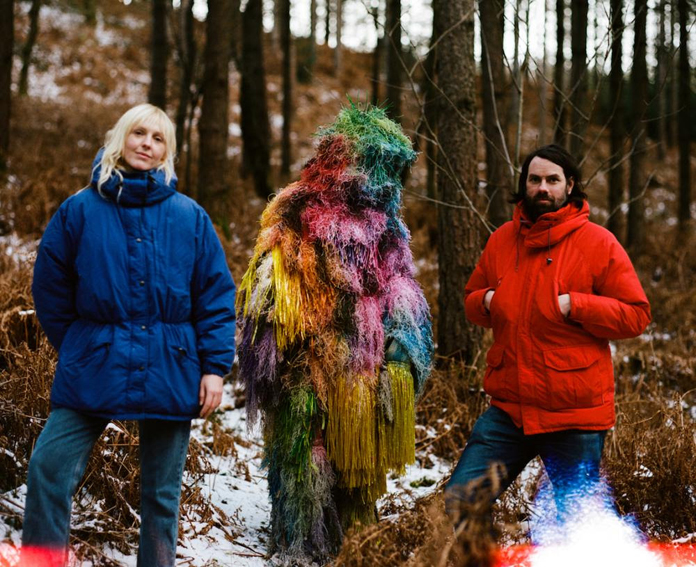
LUMP – Laura Marling and Mike Lindsay on Their New Album “Animal”
Spontaneous Psychoanalysis
Jul 29, 2021
Photography by Steph Wilson
Web Exclusive
![]()
Like a fading memory revived and now vibrant, a haunting dream brought to life, or a newly legible passage in your notebook that had long been scribbled over, the music of LUMP sounds like secrets arising from your subconscious. This suits the idiosyncratic writing process that singer Laura Marling—an acclaimed folk solo star—adopted for this side-project with Mike Lindsay, famed for his acid folk band Tunng. For their new sophomore album Animal, Marling would wait until the moment of recording to hear Lindsay’s compositions, rather than preparing in advance to sing over the ghostly hums and quirky dissonance of his analog synth soundscapes. That spontaneity lets Marling’s id roam as wild as the creature alluded to in the album’s name and pictured on its cover—a far different result than her more conventional solo lyricism.
Below, the duo tells us about creating a mascot that lives up to that uninhibited musical ethos, the benefits of old school equipment favored by David Bowie, and how psychoanalysis wasn’t therapeutic but instead inspiring for this left-of-center project.
Larry Mullin (Under the Radar): I wanted to ask about the yeti that is LUMP’s mascot. How’s he doing?
Laura Marling: Thanks for taking our mascot as seriously as we have! It was CGI for the first album, but then reborn during lockdown and became IRL. For a new album, we thought a different yeti iteration was needed. We take it seriously because it is supposed to meld together the sum of our two parts.
Mike Lindsay: It’s also taken on a few different forms for this album. There’s the embryonic LUMP from the [title track] “Animal” video. And we have a new video coming out with a multicolor yeti in IRL form. But the true LUMP lives in Laura’s basement [chuckles]. LUMP is an idea and symbol manifest physically, really, and it’s a good third member of the band.
How is this project—from the music to being a yeti’s caretaker—a refreshing departure for you both?
Laura: When Mike approached me, he had a specific thing he wanted from me. Which was a huge relief. Those parameters are freeing. Mike uses my voice as an instrument, and he’s already put paint on the canvas. I’m adding details to what he’s already made. So I don’t have to mine my own experiences for some narrative, as opposed to my solo work. There’s nothing about LUMP that is linear. It’s all a big mess of things. And I think that is liberating.
Mike: You bring more than you’re letting on, Laura. You give it life and direction, and purpose and beauty, and poetry and geography. Before Laura brings her excellence, it’s sort of a strange palate of wonk. I enjoy being in the studio and puzzling things over, then offering that up to Laura. Then she evolves it, and gives it purpose. It’s amazing for me to work with someone who is such a genius.
Laura: Carry on, Mike.
Are you always this complimentary to each other?
Mike: Usually we slap each other around and swear at each other.

What was it like to work with the same type of Eventide H949 harmonizer that David Bowie used in Berlin, Mike?
Mike: It’s so fun, so hands on. I was feeding vocals and modular synth stuff through it. It brings this special alien soundscape to your project, depending on how far you want to push it. It’s also from 1977, mind you, which is my year of birth. Sometimes you want to have a new toy or tool to really dig into when you have a new project. This one seemed to scream LUMP. Still does.
And Laura, I read you used not a new tool but a new approach: to boost spontaneity, you would not listen to Mike’s music ahead of the sessions, but instead come in fresh each day. Is that different from your solo approach?
Laura: It’s a very intentional method of working. It sort of manifested itself by the circumstances of how we started working together. I met Mike at an after show, and he said “You must come to our studio, I’ve got stuff to play for you.” I went in with no expectations, no idea of what to do. Three hours later, we had the first LUMP song.
My usual process is a daily activity of reading things, and underlining words and sentences that are well articulated. During the first LUMP album, I was reading the Surrealist Manifesto and lots of nonsense poetry. The language of those things was very present on that album. And ahead of this new album, I’d been reading a lot of psychoanalysis, and it struck me that the way I work with Mike is very psychoanalytic. So I went in with no intention of what I’d think about, other than the vernacular in my notebook of things I had written from the psychoanalysis books I was reading. Another thing that was unusual: some of the songs are written in 7/4, which is a different meter to write in. It produces unusual sentences, because it’s not your impulse to write in that meter. So you have to think about how you’re going to fit certain syllables in. It was really good fun, and very weird stuff came out, like it does in psychoanalysis—things you didn’t realize were in there.
Mike, which of the results from Laura’s unique process impressed you the most?
Mike: All of them! Kidding aside, it was really an amazing thing to witness. I had been working on that palate of songs for months. And to give them cold to Laura, who can somehow transcribe that offbeat sonic palate, and you can see her mind working, putting pen to paper, it’s really inspiring.
One of the standouts was “Gamma Ray,” which had an odd guitar riff that falls on beat two and then to beat six, and then something else comes in on beat seven. Thinking back now, I was used to it, because I had spent months on this rhythm. But to throw that on Laura, this annoying rhythm, and to try to come up with poetic lyrics, to try to tie all that together, was tough. I remember she went into the kitchen after four frustrating hours of working on it. Then, half an hour later she came back and nailed it, as if the whole thing had been planned out. And the lyrics she came up with were so evocative and dark and wonderful.
It sounds like these challenges were unlike what you faced on prior projects.
Laura: When I write as Laura Marling, I’m driven by sincerity and narrative. And I’m painting pictures of little scenarios. Which I enjoy doing. But LUMP is a really different space. I was working on this LUMP album and my latest solo album, Song For Our Daughter, simultaneously. And there were occasions where I was using the same notebook, but switched it around for each project—I’d flip to the back and turn it upside down to write for LUMP. Which is the perfect symbol of how these lyrics fit into my brain. Occasionally, “Laura’s” voice would come out, and Mike was good at noticing. Because “Laura’s” voice would be trying to tell a specific story. And everything else in LUMP is about random images that seemingly don’t have a connection to each other, but they actually do.
One point on the album that the two of them could have met: the song “Oberon.” I sang something that I had scratched into my notebook, probably as Laura. And Mike cut it up and re-jigged all the lines around so that they didn’t make sense anymore. And it created this whole different, like a collage or something—a totally different picture.
Mike, what inspired that re-jigging?
Mike: The “Oberon” music is very simple [spreads fingers to mime piano playing]. We didn’t have that much time left that day. So I asked her: “Before you go, check out this other one.” I remember her looking through her notebook, saying, “Maybe I have something.” And I just had the mic up, and, Laura, I got you ad-libbing four or five different versions. And you were just listening and singing in real time, plucking out bits from your notebook that made sense. Then you had to run, and I was left with these mini versions of similar words in different places. It was great to be able to jigsaw that together. But listening back, it feels extremely decided.
Laura: Hmmm [in agreement].
Mike: It feels very natural and organic. And that’s exactly how it’s supposed to be. It’s great when that happens. It’s a process.
So what’s the next step in LUMP’s process, now that the album is done and you’re releasing it?
Mike: I’m really looking forward to playing this live, experiencing interaction, and getting audience’s ribcages vibrating. The last LUMP record lent itself to live shows, and that’s one of the reasons why we decided to make another. We’ve been rehearsing, and even though it’s just a handful of shows, I’m really looking forward to them. Especially after such a long lockdown. I don’t know about you, Laura?
Laura: Very much so. My usual routine of going to the library every day or sitting outside somewhere reading, was upended by the lockdown. I had to get comfortable with being at home and not being able to go out and write or tour. So, I wasn’t very productive, unlike a lot of other musicians.
Mike: Oh, I don’t know, you inspired a lot of people with your online live guitar lesson.
Laura: True. I guess I was thinking more selfishly!
(Animal is due out tomorrow, July 30, via Partisan/Chrysalis.)

Also read our 2018 interview with LUMP.
Support Under the Radar on Patreon.
Current Issue

Issue #72
Apr 19, 2024 Issue #72 - The ‘90s Issue with The Cardigans and Thurston Moore
Most Recent
- Under the Radar Announces The ’90s Issue with The Cardigans and Thurston Moore on the Covers (News) — The Cardigans, Thurston Moore, Sonic Youth, Garbage, The Cranberries, Pavement, Lisa Loeb, Supergrass, Spiritualized, Lush, Miki Berenyi, Miki Berenyi Trio, Emma Anderson, Hatchie, Ride, Slowdive, Velocity Girl, Penelope Spheeris, Terry Gilliam, Gus Van Sant, Ron Underwood, Kula Shaker, Salad, Foals, Semisonic, The Boo Radleys, Stereo MC’s, Pale Saints, Blonde Redhead, Sleater-Kinney, Cocteau Twins, Lucy Dacus, Alex Lahey, Horsegirl, Grandaddy, alt-J, Squid, The Natvral, Wolf Alice, Jess Williamson, Sunflower Bean, Orville Peck, Joel McHale
- Fresh Shares New EP ‘Merch Girl’ (News) — Fresh
- Premiere: LOVECOLOR Shares New Video for “Crazy Love” (News) — LOVECOLOR
- Final Summer (Review) — Cloud Nothings
- Tallinn Music Week, Tallinn, Estonia, April 3-7, 2024 (Review) — Virta, Musta Huone, Mari Kalkun, Sven Grünberg

Comments
Submit your comment
There are no comments for this entry yet.